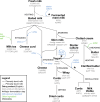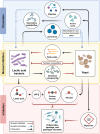Microbial dynamics and Pseudomonas natural product production in milk and dairy products
- PMID: 40028703
- PMCID: PMC11874467
- DOI: 10.1039/d4np00074a
Microbial dynamics and Pseudomonas natural product production in milk and dairy products
Abstract
Covering: 2000 up to the first half of 2024Milk and its derived dairy products have long been integral to the human diet, with evidence of consumption dating back over 9000 years. Milk's high nutritional value renders dairy products an important element of human diet while also offering a fertile environment for microbial growth. Beneficial microorganisms in dairy products are often associated with biogenic and probiotic effects, whereas spoilage or pathogenic microorganisms can pose health risks. Fermentation is a key method to preserve milk. Whereas dairying practices in most parts of the world have been highly altered by industrialization over the past century, nomadic pastoralists in Mongolia notably retain a rich tradition of household-level dairy fermentation that has been practiced since 3000 BC. Milk-associated microorganisms produce a vast number of low molecular weight natural products that can mediate beneficial and detrimental interactions. Bacteria of the genus Pseudomonas are found in traditional Mongolian dairy products and are common contaminants in commercial dairy products, and they can strongly impact the quality and shelf-life of dairy products. These bacteria are well known for their ability to produce a variety of secondary metabolites, including nonribosomal (lipo)peptides, which are both structurally and functionally diverse. Lipopeptides can have antimicrobial properties, act as quorum sensing molecules, and contribute to biofilm formation due to their amphiphilic nature. Although often associated with spoilage, some of these natural products can also exhibit positive effects with potential beneficial applications in the dairy industry. This review aims to provide a comprehensive overview of the interplay between culinary fermentation and the production and activities of microbial-derived natural products.
Conflict of interest statement
There are no conflicts to declare.
Figures









Similar articles
-
The Black Book of Psychotropic Dosing and Monitoring.Psychopharmacol Bull. 2024 Jul 8;54(3):8-59. Psychopharmacol Bull. 2024. PMID: 38993656 Free PMC article. Review.
-
Ruminant nutrition symposium: novel microbial solutions to optimize production efficiency in beef and dairy systems.J Anim Sci. 2025 Jan 4;103:skaf165. doi: 10.1093/jas/skaf165. J Anim Sci. 2025. PMID: 40372016 Free PMC article. Review.
-
Management of urinary stones by experts in stone disease (ESD 2025).Arch Ital Urol Androl. 2025 Jun 30;97(2):14085. doi: 10.4081/aiua.2025.14085. Epub 2025 Jun 30. Arch Ital Urol Androl. 2025. PMID: 40583613 Review.
-
Short-Term Memory Impairment.2024 Jun 8. In: StatPearls [Internet]. Treasure Island (FL): StatPearls Publishing; 2025 Jan–. 2024 Jun 8. In: StatPearls [Internet]. Treasure Island (FL): StatPearls Publishing; 2025 Jan–. PMID: 31424720 Free Books & Documents.
-
Sexual Harassment and Prevention Training.2024 Mar 29. In: StatPearls [Internet]. Treasure Island (FL): StatPearls Publishing; 2025 Jan–. 2024 Mar 29. In: StatPearls [Internet]. Treasure Island (FL): StatPearls Publishing; 2025 Jan–. PMID: 36508513 Free Books & Documents.
References
-
- Evershed R. P. Payne S. Sherratt A. G. Copley M. S. Coolidge J. Urem-Kotsu D. Kotsakis K. Özdoğan M. Özdoğan A. E. Nieuwenhuyse O. Akkermans P. M. M. G. Bailey D. Andeescu R.-R. Campbell S. Farid S. Hodder I. Yalman N. Özbaşaran M. Bıçakcı E. Garfinkel Y. Levy T. Burton M. M. Nature. 2008;455:528–531. doi: 10.1038/nature07180. - DOI - PubMed
-
- Peters J., Pöllath N. and Arbuckle B. S., The emergence of livestock husbandry in Early Neolithic Anatolia, Oxford University Press, Oxford, UK, 2017
-
- Daly K. G. Mattiangeli V. Hare A. J. Davoudi H. Fathi H. Doost S. B. Amiri S. Khazaeli R. Decruyenaere D. Nokandeh J. Richter T. Darabi H. Mortensen P. Pantos A. Yeomans L. Bangsgaard P. Mashkour M. Zeder M. A. Bradley D. G. Proc. Natl. Acad. Sci. U.S.A. 2021;118:e2100901118. doi: 10.1073/pnas.2100901118. - DOI - PMC - PubMed
-
- Daly K. G. Maisano Delser P. Mullin V. E. Scheu A. Mattiangeli V. Teasdale M. D. Hare A. J. Burger J. Verdugo M. P. Collins M. J. Kehati R. Erek C. M. Bar-Oz G. Pompanon F. Cumer T. Çakırlar C. Mohaseb A. F. Decruyenaere D. Davoudi H. Çevik Ö. Rollefson G. Vigne J.-D. Khazaeli R. Fathi H. Doost S. B. Rahimi Sorkhani R. Vahdati A. A. Sauer E. W. Azizi Kharanaghi H. Maziar S. Gasparian B. Pinhasi R. Martin L. Orton D. Arbuckle B. S. Benecke N. Manica A. Horwitz L. K. Mashkour M. Bradley D. G. Science. 2018;361:85–88. doi: 10.1126/science.aas9411. - DOI - PubMed
-
- Sandoval-Castellanos E. Hare A. J. Lin A. T. Dimopoulos E. A. Daly K. G. Geiger S. Mullin V. E. Wiechmann I. Mattiangeli V. Lühken G. Zinovieva N. A. Zidarov P. Çakırlar C. Stoddart S. Orton D. Bulatović J. Mashkour M. Sauer E. W. Horwitz L. K. Horejs B. Atici L. Özkaya V. Mullville J. Parker Pearson M. Mainland I. Card N. Brown L. Sharples N. Griffiths D. Allen D. Arbuckle B. Abell J. T. Duru G. Mentzer S. M. Munro N. D. Uzdurum M. Gülçur S. Buitenhuis H. Gladyr E. Stiner M. C. Pöllath N. Özbaşaran M. Krebs S. Burger J. Frantz L. Medugorac I. Bradley D. G. Peters J. Sci. Adv. 2024;10:eadj0954. doi: 10.1126/sciadv.adj0954. - DOI - PMC - PubMed
Publication types
MeSH terms
Substances
LinkOut - more resources
Full Text Sources
Molecular Biology Databases
Miscellaneous

